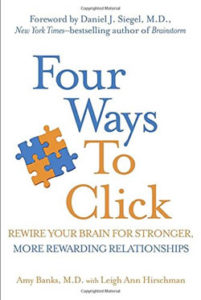
Reviewed by: Michael Fiorini, New York University
Four Ways to Click: Rewire Your Brain for Stronger, More Rewarding Relationships is a self-help book designed to illustrate, via a strongly neuroscience-based framework, the nature of reader’s personal relationships. The goal of the book is, ostensibly, to identify the reader’s strong and weak relationships through included evaluations and map out actions that can improve them. The explicit goal is to change the way readers’ brains are wired through interventions that target four specific brain regions as outlined in the book’s “C.A.R.E. Plan.”
C.A.R.E., here, abbreviates calm, accepted, resonant, and energetic, which are the book’s terminology for explaining the brain regions affecting those feelings. The essential concern of the book is to make the concept of neuroplasticity understandable for readers without a background in neuroscience, and to this end it puts an impressive degree of detail outlining effective framing techniques and evaluative considerations in all forms of relationships. Although there is a definite slant towards non-professional readership due to its self-help structure and presentation style, it is nonetheless a useful guide for relating neuroscience to relationship development. Professional readers will, thus, find it an excellent framing tool for marriage or relationship therapy goal formation and intervention. It also has potential as a guiding tool for those clients dealing with a shortage of meaningful friendships, or an abundance of negative ones.
 Four Ways to Click structures the information it presents around its “C.A.R.E. Plan.” Targeted areas of interest are the smart vagus, dorsal anterior cingulate cortex, the mirror neuron system, and the dopaminergic system, respectively. The book first details for readers a way to reconsider their relationships, with the opening chapter covering the way in which certain boundaries within them are unproductive. The next chapter details the four aforementioned neural pathways of concern for healthy relationships. The third chapter covers the three rules of brain change, dealing with neuronal entanglement, the vocation of repetition, and competitive neuroplasticity. The fourth chapter focuses on self-assessment and how to consider particular results from those assessments. The next four chapters cover each of the facets of the C.A.R.E. Plan in greater detail in light of the reader’s self-evaluation results and through incorporation of illustrative examples and clinical case studies. The end of the book relates to practices undertaken for improving overall brain health.
Four Ways to Click structures the information it presents around its “C.A.R.E. Plan.” Targeted areas of interest are the smart vagus, dorsal anterior cingulate cortex, the mirror neuron system, and the dopaminergic system, respectively. The book first details for readers a way to reconsider their relationships, with the opening chapter covering the way in which certain boundaries within them are unproductive. The next chapter details the four aforementioned neural pathways of concern for healthy relationships. The third chapter covers the three rules of brain change, dealing with neuronal entanglement, the vocation of repetition, and competitive neuroplasticity. The fourth chapter focuses on self-assessment and how to consider particular results from those assessments. The next four chapters cover each of the facets of the C.A.R.E. Plan in greater detail in light of the reader’s self-evaluation results and through incorporation of illustrative examples and clinical case studies. The end of the book relates to practices undertaken for improving overall brain health.
Using a wide array of neuroscientific information, Four Ways to Click, although seemingly simplistic at first, gives readers a fairly in-depth understanding of how their brains impact and are influenced by their close relationships. It also accomplishes the translation of a great deal of complex knowledge without coming off as dry or dense, something that readers aimed towards self-help will appreciate. It is an important factor to consider for professional readers either not accustomed to incorporating a neuroscience modality to their work or who otherwise need to be brought up to speed on how it might play a meaningful role in the relationships of clients.
As an outlining guide it can be useful in therapy, either directly or indirectly, both in client evaluation and intervention construction. For those readers who are already acquainted with neuroscience as it relates to cognition and interpersonal relationships, the book will prove rather redundant and reductive in scope as compared to formal training regarding the topic. Having said that, if one feels the need to brush up on adaptive neuroscience in a way that would be easier for clients to understand, it might still prove useful. Researchers and students, in spite of the clinical and personal vocations of the book, will not be able to utilize it for research, however, as there are very few citations and resources included here.
Amy Banks, MD, is a former instructor of psychiatry at Harvard Medical School, and currently works as director of Advanced training at the Jean Baker Miller Training Institute at the Wellesley Centers for Women. She runs a private practice that specializes in relational psychopharmacology as well as conducting therapy for sufferers of chronic disconnection.
Banks, A. (2015). Four Ways to Click: Rewire Your Brain for Stronger, More Rewarding Relationships. New York, NY: Penguin. ISBN: 978-0-399-16919-9. Hardcover. 308 pages. Includes index and notes.
For information about Dr. Banks, click here.







